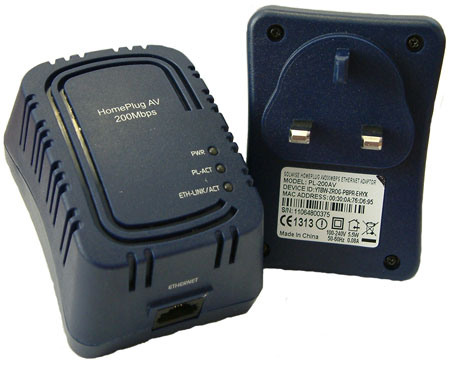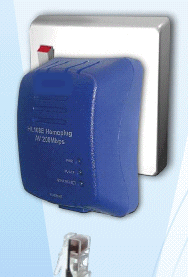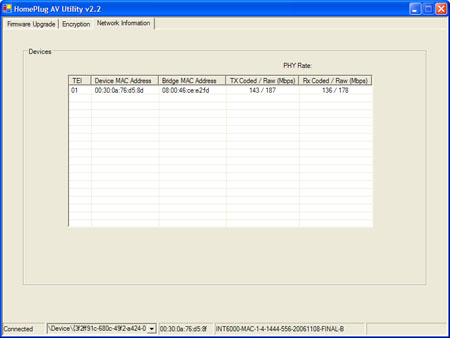Original URL: https://www.theregister.com/2007/02/05/review_solwise_homeplug_av/
Solwise PL-200AV 200Mbps powerline Ethernet adaptor
The cure for wobbly Wi-Fi?
Posted in Personal Tech, 5th February 2007 13:02 GMT
Review Devolo's first HomePlug AV powerline Ethernet adaptor, the dLAN 200 AVdesk, wasn't a unit that plugs straight into a mains power socket, unlike Netgear's HDX101, which I reviewed last week and, for that matter, UK vendor Solwise's 200Mbps PL-200AV product. But while the HDX101 and the Solwise use much the same form-factor, they're based on different technologies.
HomePlug AV is the HomePlug Alliance's 200Mbps specification, incompatible but capable of co-existing with the original 14Mbps HomePlug 1.0 standard and its 85Mbps extension, HomePlug Turbo. None of them will talk to Opera-based boxes like Netgear's HDX101 and products from D-Link.

Solwise's PL-200AV units are smaller and less chunky than the Netgear product, though not as compact as 85Mbps units I've tried in the past. They're still too big for multi-port sockets - you may have a job getting even a standard-size plug in next to one - and they follow the usual pattern: mains pins on the back, 10/100Mbps Ethernet port on the base. Yet again, the MAC and device ID numbers are written on the back of the device, so make sure you scribble these down before you plug it in.
Like the Devolo AVdesk, the PL-200AV is based on Intellon's INT6000 HomePlug AV chipset. The 200Mbps is, of course, the theoretical maximum that the adaptor is capable of pumping out raw data. Allow for error correction and other control traffic, and you're looking at a best-case scenario of 120Mbps. In the real word, the typical throughput lies somewhere between 50Mbps and 70Mbps, depending on the state of your mains wiring, hence the 100Mbps Ethernet port, which might seem at first too slow for a 200Mbps system.
So how realistic are those numbers, provided by Solwise? Once again, I connected a MacBook Pro and a Sony Vaio notebook between upstairs and downstairs rooms in my home. By necessity, the upstairs box was connected to a small extension cable. Powerline Ethernet adaptor suppliers warn against using multi-socket boards, but I had to and so, I suspect, will many other users. The key, I'm told, is to make sure the board doesn't contain surge-protection circuitry - that's the killer. For testing, I used a simple two-socket extension cable with nothing plugged into the second socket.
The two machines were set up to operate on a closed IP network with manually entered IP addresses. Plugging in the first PL-200AV sets it searching for other devices and it quickly spotted the second PL-200AV when I plugged it in. Just like the Devolo AVdesk pairing, the two PL-200AVs negotiated their connection very quickly, handy not just when you're connecting them for the first time but also in coping with sudden signal loss arising from the inevitable noise on the mains wiring.

Just as I had with previous powerline Ethernet tests, I ran the open source network testing tool iperf to measure the link's TCP and UDP bandwidth. I got 50Mbps and 59.4Mbps, respectively - using Windows XP's Task Manager utility to track network activity, I got 52 per cent utilisation of the laptop's 100Mbps Ethernet port for TCP and 61 per cent for UDP, translating to effectively 52Mbps and 61Mbps.
Those numbers compare to the 56Mbps and 59.4Mbps - respectively, TCP and UDP bandwidth - iperf recorded for the HDX101 pairing, and the 50.6Mbps and 59.4Mbps it measured using the Devolo units in the same set-up.
It's perhaps worth pointing out here that while the iperf test was running, the PL-200AV pairing generated a much smoother trace in Task Manager than the HDX101s had, suggesting it experienced far fewer sudden dips in signal than the HDX101s did, or that the two Solwise boxes were able to recover from them much more quickly.
Next, I set up the open source media playback and streaming application VLC to stream a 1080i HD video encoded in MPEG 2 from the PC to the Mac. Playback on the MacBook Pro was as smooth as anything. There was clearly sufficient bandwidth to send the same video simultaneously from the Mac to the PC, although playback on the PC was very juddery because its GPU and CPU together lack the power to decode the image data smoothly but not, I'd say, for reasons of limited bandwidth.
While streaming the video to the Mac, I also measured the remaining available TCP bandwidth using iperf. Devolo's old 85Mbps adaptors, which I reviewed early last year, can smoothly transmit the HD stream, running iperf alongside it caused some picture break-up and yielded an available bandwidth figure of just 3.7Mbps. The HDX101s played the HD video but yielded spare TCP bandwidth of 37.9-54.7Mbps, depending on whether their quality-of-service algorithms were set to favour UDP or TCP - favouring the latter resulted in higher bandwidth but some picture break-up.
The PL-200PE ship with software that provides no control over the QoS, but I understand it's pre-set to favour UDP traffic, the better to support streamed video, an application that usually relies on UDP. With iperf, I measured a 'spare' TCP bandwidth of 40.4Mbps and UDP throughput of 30.4Mbps. The 1080i HD video played smoothly throughout the tests.

Click for full-size screenshot
The Windows-only software bundled with each PL-200AV is basic, limited to providing a means to update adaptors' firmware and an opportunity to change the password that's automatically used to encrypt data sent back and forth between adaptors.
Solwise doesn't offer the PL-200AV in two-unit networking start packs as the other vendors I've looked at do. But since there's generally only a few pounds saving to be made buying the bundle, that's not a big problem. Solwise is asking £71 inc. VAT for its top-speed powerline adaptors, just £6 more than the HDX101s, £29 less than than Devolo dLAN AVdesk units and £14 less than the socket-fitting dLAN 200 AVs Devolo is now offering.
I you're a Windows user, the Solwise PL-200AV units are the best buy for a HomePlug AV compatible set-up and the Netgear HDX101 for the lowest price. Mac and Linux users, however, should consider forking out the extra for the Devolo units, as it's the only one of the three to provide versions of its adaptor configuration utility for those platforms, and such work ought to be rewarded. All the adaptors reviewed will, however, work without the need to run the configuration software, so in that sense the devices are all platform-agnostic.
In light of my experiences of late with 802.11g Wi-Fi - problems a great many Reg Hardware readers share, if the 70-odd emails I've received are anything to go by - it's hard not to recommend powerline Ethernet networking. Its performance is potentially well below the headline number the standard bodies and vendors like to shout about, but then so too is Wi-Fi. Even at the bottom of the range, the throughput is better than 802.11g and safe, in most cases, from other networks interfering with yours.
Verdict
Solwise's PL-200AV is a good powerline Ethernet adaptor. The price is good, the software could be better, but it's really performance that matters, and the units deliver. You'll never get 200Mbps, but you should certainly beat current Wi-Fi standards - without the risk of interference from other signal sources, more to the point.